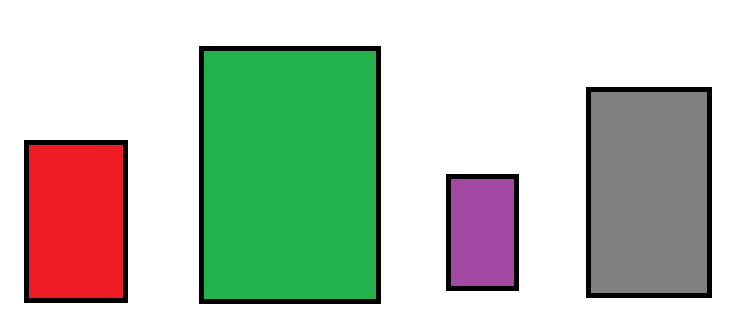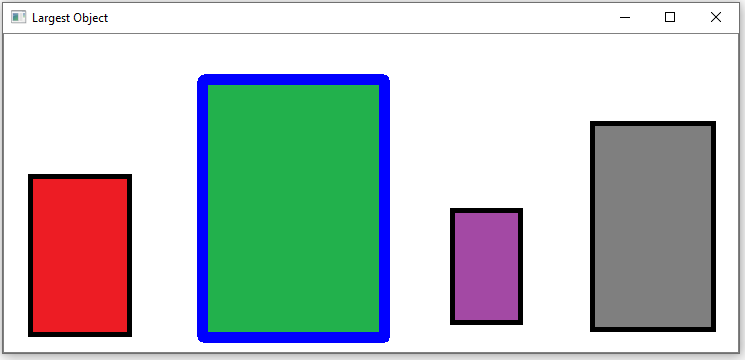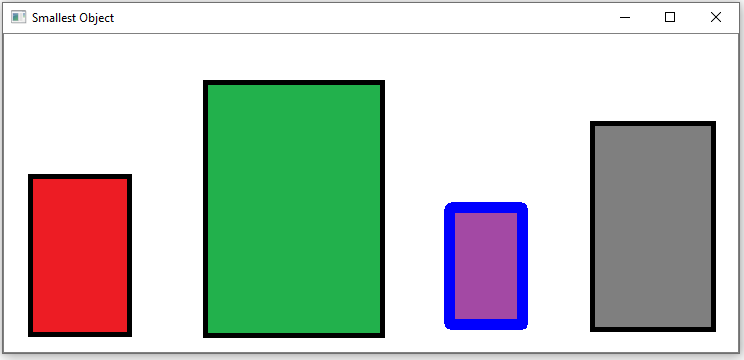How to Find the Largest or Smallest Object in an Image in Python using OpenCV

In this article, we show how to find the largest or smallest object in an image in Python using the OpenCV module.
OpenCV is very dynamic in which we can first find all the objects (or contours) in an image using the cv2.findContours() function. We can then find the size of each object using the cv2.contourArea() function. We then organize these from largest to smallest or smallest or largest to get the largest or smallest object in our image.
So this is what we will do in this case.
In this example, we will be working with the following image shown below.

As you can see in the above image, there are 4 rectangles, which we will say represents containers.
You can clearly see that the green rectangle is the largest object in this image.
The purple rectangle is the smallest object.
Below we'll see how this works in code.
How to Find the Largest Object in an Image
We will first create code to find the largest object in this image and then we will draw an outline along the outer contour of the image.
This will produce the following image below.

Let's now go over this code.
First, we import OpenCV using the line, import cv2
Next, we read in the image, which in this case is, Containers.png
We create the variable, original_image, to store the original image that will undergo modification throughout the code.
We create a grayscale version of the image and then find the Canny edges, which helps simplify the image for cvs.findContours() function. The cv2.findContours() function finds all external contours in our image, which finds the unique objects in an image.
We then create a function that finds all the areas of each of the contours in our image and stores this in a list in the variable, all_areas. This function returns this list.
We then sort this list from largest to smallest using the sorted() function. We store this sorted list into the variable, sorted_contours. We sort a list from largest to smallest by the attribute, reverse=True. To sort a list from smallest to largest by the attribute, reverse= False, or by specifying nothing in the reverse attribute, as reverse=False, is implied if not specified.
Now that the list is sorted from largest to smallest, the first item in the list is the largest item, which represents the largest object in our image. We get the largest item with the code, largest_item= sorted_contours[0]
Lists always started with an index of 0. So the 0 index item is the first item and, thus, the largest object.
We then outline this largest object in blue with the drawContours() function.
How to Find the Smallest Object in an Image
We will first create code to find the smallest object in this image and then we will draw an outline along the outer contour of the image.
This will produce the following image below.

So everything is the same as before, except now we specify in the sorted() function that, reverse= False
Now the list is sorted from smallest to largest.
Therefore, now, the first item of the list is the smallest object.
And this is how we can find the largest or smallest object
in an image by size in Python using OpenCV.
Related Resources
How to Draw a Rectangle in Python using OpenCV
How to Draw a Circle in Python using OpenCV
How to Draw a Line in Python using OpenCV
How to Add Text to an Image in Python using OpenCV
How to Display an OpenCV image in Python with Matplotlib
How to Use Callback functions to Connect Images to Events in Python using OpenCV
How to Check for Multiple Events in Python using OpenCV
